Food Safety Management: Contamination, Preservation, and Legislation
VerifiedAdded on 2019/12/17
|24
|6448
|253
Report
AI Summary
This report provides a comprehensive overview of food safety management, addressing critical aspects such as food contamination, preservation methods, and relevant legislation. The report begins by defining food contamination, detailing various sources and controls to prevent it, including physical and chemical contamination, and the role of hygiene practices. It explores methods for safe food storage, emphasizing temperature control, personal hygiene, cleaning, and pest control. Furthermore, it discusses the importance of hygiene in premises design and staff training, along with food safety control measures and related legislation. The report also examines foodborne illnesses, including the differences between food poisoning and foodborne infections, along with the agents of food spoilage. Overall, this report serves as a valuable resource for understanding and implementing effective food safety practices, ensuring the health and safety of consumers.
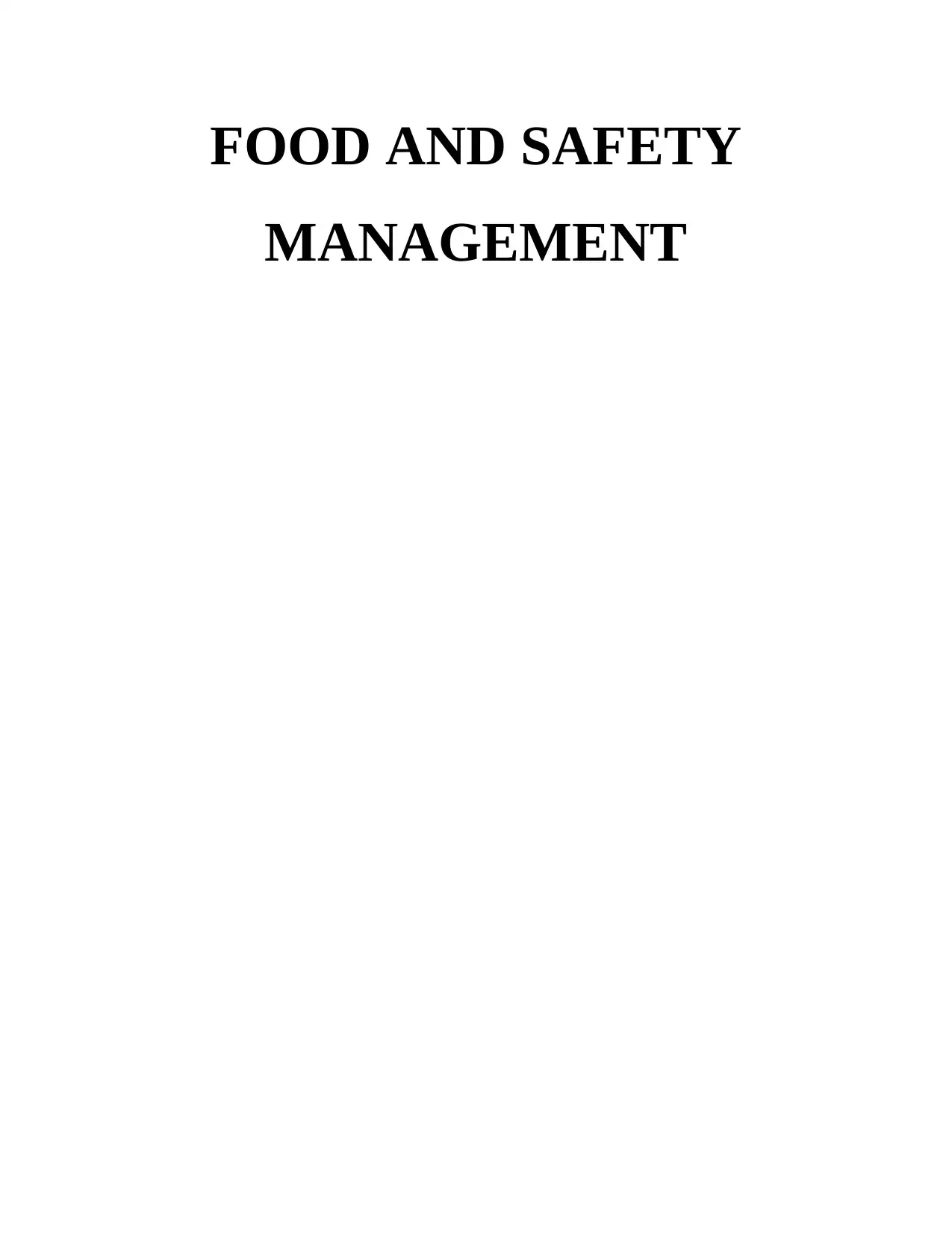
FOOD AND SAFETY
MANAGEMENT
MANAGEMENT
Paraphrase This Document
Need a fresh take? Get an instant paraphrase of this document with our AI Paraphraser
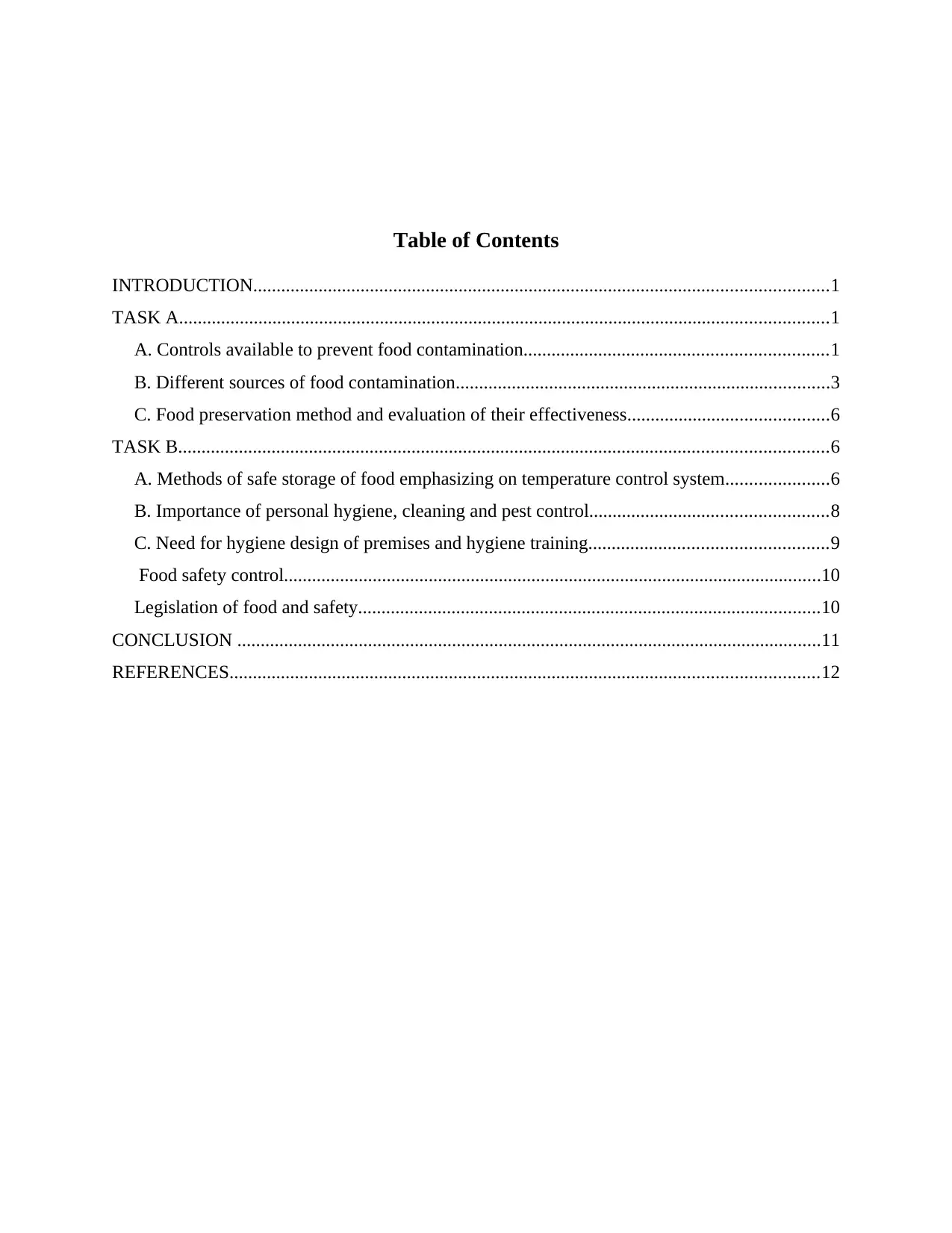
Table of Contents
INTRODUCTION...........................................................................................................................1
TASK A...........................................................................................................................................1
A. Controls available to prevent food contamination.................................................................1
B. Different sources of food contamination................................................................................3
C. Food preservation method and evaluation of their effectiveness...........................................6
TASK B...........................................................................................................................................6
A. Methods of safe storage of food emphasizing on temperature control system......................6
B. Importance of personal hygiene, cleaning and pest control...................................................8
C. Need for hygiene design of premises and hygiene training...................................................9
Food safety control...................................................................................................................10
Legislation of food and safety...................................................................................................10
CONCLUSION .............................................................................................................................11
REFERENCES..............................................................................................................................12
INTRODUCTION...........................................................................................................................1
TASK A...........................................................................................................................................1
A. Controls available to prevent food contamination.................................................................1
B. Different sources of food contamination................................................................................3
C. Food preservation method and evaluation of their effectiveness...........................................6
TASK B...........................................................................................................................................6
A. Methods of safe storage of food emphasizing on temperature control system......................6
B. Importance of personal hygiene, cleaning and pest control...................................................8
C. Need for hygiene design of premises and hygiene training...................................................9
Food safety control...................................................................................................................10
Legislation of food and safety...................................................................................................10
CONCLUSION .............................................................................................................................11
REFERENCES..............................................................................................................................12

⊘ This is a preview!⊘
Do you want full access?
Subscribe today to unlock all pages.

Trusted by 1+ million students worldwide
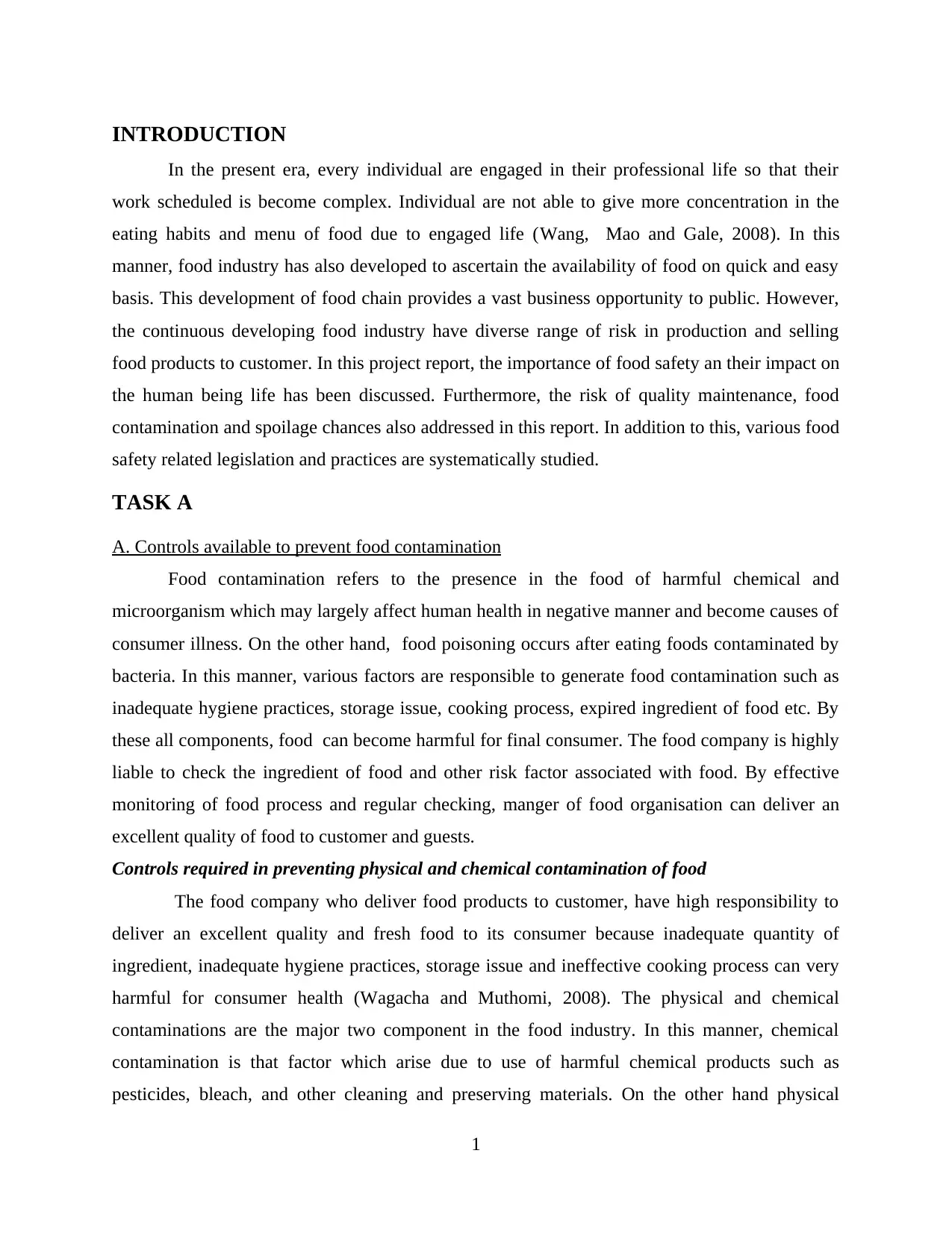
INTRODUCTION
In the present era, every individual are engaged in their professional life so that their
work scheduled is become complex. Individual are not able to give more concentration in the
eating habits and menu of food due to engaged life (Wang, Mao and Gale, 2008). In this
manner, food industry has also developed to ascertain the availability of food on quick and easy
basis. This development of food chain provides a vast business opportunity to public. However,
the continuous developing food industry have diverse range of risk in production and selling
food products to customer. In this project report, the importance of food safety an their impact on
the human being life has been discussed. Furthermore, the risk of quality maintenance, food
contamination and spoilage chances also addressed in this report. In addition to this, various food
safety related legislation and practices are systematically studied.
TASK A
A. Controls available to prevent food contamination
Food contamination refers to the presence in the food of harmful chemical and
microorganism which may largely affect human health in negative manner and become causes of
consumer illness. On the other hand, food poisoning occurs after eating foods contaminated by
bacteria. In this manner, various factors are responsible to generate food contamination such as
inadequate hygiene practices, storage issue, cooking process, expired ingredient of food etc. By
these all components, food can become harmful for final consumer. The food company is highly
liable to check the ingredient of food and other risk factor associated with food. By effective
monitoring of food process and regular checking, manger of food organisation can deliver an
excellent quality of food to customer and guests.
Controls required in preventing physical and chemical contamination of food
The food company who deliver food products to customer, have high responsibility to
deliver an excellent quality and fresh food to its consumer because inadequate quantity of
ingredient, inadequate hygiene practices, storage issue and ineffective cooking process can very
harmful for consumer health (Wagacha and Muthomi, 2008). The physical and chemical
contaminations are the major two component in the food industry. In this manner, chemical
contamination is that factor which arise due to use of harmful chemical products such as
pesticides, bleach, and other cleaning and preserving materials. On the other hand physical
1
In the present era, every individual are engaged in their professional life so that their
work scheduled is become complex. Individual are not able to give more concentration in the
eating habits and menu of food due to engaged life (Wang, Mao and Gale, 2008). In this
manner, food industry has also developed to ascertain the availability of food on quick and easy
basis. This development of food chain provides a vast business opportunity to public. However,
the continuous developing food industry have diverse range of risk in production and selling
food products to customer. In this project report, the importance of food safety an their impact on
the human being life has been discussed. Furthermore, the risk of quality maintenance, food
contamination and spoilage chances also addressed in this report. In addition to this, various food
safety related legislation and practices are systematically studied.
TASK A
A. Controls available to prevent food contamination
Food contamination refers to the presence in the food of harmful chemical and
microorganism which may largely affect human health in negative manner and become causes of
consumer illness. On the other hand, food poisoning occurs after eating foods contaminated by
bacteria. In this manner, various factors are responsible to generate food contamination such as
inadequate hygiene practices, storage issue, cooking process, expired ingredient of food etc. By
these all components, food can become harmful for final consumer. The food company is highly
liable to check the ingredient of food and other risk factor associated with food. By effective
monitoring of food process and regular checking, manger of food organisation can deliver an
excellent quality of food to customer and guests.
Controls required in preventing physical and chemical contamination of food
The food company who deliver food products to customer, have high responsibility to
deliver an excellent quality and fresh food to its consumer because inadequate quantity of
ingredient, inadequate hygiene practices, storage issue and ineffective cooking process can very
harmful for consumer health (Wagacha and Muthomi, 2008). The physical and chemical
contaminations are the major two component in the food industry. In this manner, chemical
contamination is that factor which arise due to use of harmful chemical products such as
pesticides, bleach, and other cleaning and preserving materials. On the other hand physical
1
Paraphrase This Document
Need a fresh take? Get an instant paraphrase of this document with our AI Paraphraser

contamination refers to those component which cause the risk of food adulteration due to
personal carelessness of food staff. Physical contamination can control by the individual at the
time of food processing and cooking. In order to control the physical and chemical
contamination, company can use the 4 P's measures which are as follows- People- In the process of food producing, staff members have major role in order to
control the physical and chemical contamination. In this manner, staff members, chefs
and management requires to focus on the control factor and safely carry all activities of
cooking. They can control the risk and harmful effects by conducting safe and clean
environment and place (Tsola and et. al., 2008). Dirty surrounding, muddy water,
unhygienic practices may arise food contamination. Management should influence the
practices of regular hand wash, wearing gloves and hairnet by staff of kitchen or chef. Product- In this context, management requires to conduct effective trainings and
monitoring of staff members about the raw material specification and inspection. By this
practices, management influence the product safety by maintaining the quality of
products from the scrape. Premises- This is another harmful aspect in order to generate the food contamination in
the human being. In this manner, unhealthy surroundings, unhealthy facilities are
included. Management should requires to use high quality equipments so as this type of
risk can prevent and control. Further, they should regular repair and maintain glass of
kitchen and plastics shields so as they can prevent from physical and chemical
contamination.
Pests-This is another major concern in the food and safety management. Pest problem in
the food company and restaurant may be generated by diverse range of activities such as
unhealthy surrounding, dirty water, unclean floor, usage of harmful chemical products,
no pest control etc. So that management should consider on effective facility
management, seasonal pest control activities and using pest control devices so as they can
lead effective control on the management of food.
Chemical safety is an important consideration for any workplace using volatile substance.
Preventing chemical contamination is large part of ensuring safety in the workplace. There are
six ways to prevent chemical contamination from presenting itself which are as follows-
2
personal carelessness of food staff. Physical contamination can control by the individual at the
time of food processing and cooking. In order to control the physical and chemical
contamination, company can use the 4 P's measures which are as follows- People- In the process of food producing, staff members have major role in order to
control the physical and chemical contamination. In this manner, staff members, chefs
and management requires to focus on the control factor and safely carry all activities of
cooking. They can control the risk and harmful effects by conducting safe and clean
environment and place (Tsola and et. al., 2008). Dirty surrounding, muddy water,
unhygienic practices may arise food contamination. Management should influence the
practices of regular hand wash, wearing gloves and hairnet by staff of kitchen or chef. Product- In this context, management requires to conduct effective trainings and
monitoring of staff members about the raw material specification and inspection. By this
practices, management influence the product safety by maintaining the quality of
products from the scrape. Premises- This is another harmful aspect in order to generate the food contamination in
the human being. In this manner, unhealthy surroundings, unhealthy facilities are
included. Management should requires to use high quality equipments so as this type of
risk can prevent and control. Further, they should regular repair and maintain glass of
kitchen and plastics shields so as they can prevent from physical and chemical
contamination.
Pests-This is another major concern in the food and safety management. Pest problem in
the food company and restaurant may be generated by diverse range of activities such as
unhealthy surrounding, dirty water, unclean floor, usage of harmful chemical products,
no pest control etc. So that management should consider on effective facility
management, seasonal pest control activities and using pest control devices so as they can
lead effective control on the management of food.
Chemical safety is an important consideration for any workplace using volatile substance.
Preventing chemical contamination is large part of ensuring safety in the workplace. There are
six ways to prevent chemical contamination from presenting itself which are as follows-
2

Clear Labels- One of the easiest ways in order to prevent chemical contamination at
workplace is by clearly labelling each substance. The labels should ideally includes the
name of the products, the expiry date and disposal methods, the danger and clean up
instructions in case of a accident. Clear label can provide an effective understanding
about the product and services which offers to the customer. With help of the clear label,
individual can understand about the contain which mixed.
Chemical storage cabinets- Chemical storage cabinet are a important consideration for
every workplace using chemicals. They ensure the volatile substance are stored securely
without a risk of contamination. With help of this aspect, there may overcome the
chances of the risk, uncertain accidents, hazard at the workplace.
Cleaning material- The correct cleaning material should kept in a designed area of the
workplace in case a spill or accidents occurs. This should including safety clothing to
wear while cleaning and a spill kit for hazardous waste. This is one of the most important
aspect by which company can protect its customer from the infection of food. With help
of this aspect, infection rate in the food material can overcome easily.
Measures to control food-borne illness
Food borne illness refers to that illness which occurs in the human body by consumption of
unhealthy food, contaminated food, bacteria or viruses etc. These all mentioned component
generate the reason opf illness and lead to fatal health issue at times depending on the amount of
consumption. In order to control this types of illness in the consumer, restaurant staff or
management should consider on the various practices which are as follows- Quality check- Management of restaurant should regular check the quality of food
through which they can minimise the risk of food borne illness. In this manner,
management needs to check the final dishes and process of cooking in order to assure the
standard quality of it (Sampers and et.al., 2012). By this practice, restaurant can
overcome the risk of food borne illness in the consumer who will consume the food. Excellent quality of raw material- This is another important measure through which
management can able to improve the quality of food and overcome the risk of food borne
illness. In this manner, management should use high standard quality of raw material and
ingredients of the products in the production of food. The raw material and ingredients of
3
workplace is by clearly labelling each substance. The labels should ideally includes the
name of the products, the expiry date and disposal methods, the danger and clean up
instructions in case of a accident. Clear label can provide an effective understanding
about the product and services which offers to the customer. With help of the clear label,
individual can understand about the contain which mixed.
Chemical storage cabinets- Chemical storage cabinet are a important consideration for
every workplace using chemicals. They ensure the volatile substance are stored securely
without a risk of contamination. With help of this aspect, there may overcome the
chances of the risk, uncertain accidents, hazard at the workplace.
Cleaning material- The correct cleaning material should kept in a designed area of the
workplace in case a spill or accidents occurs. This should including safety clothing to
wear while cleaning and a spill kit for hazardous waste. This is one of the most important
aspect by which company can protect its customer from the infection of food. With help
of this aspect, infection rate in the food material can overcome easily.
Measures to control food-borne illness
Food borne illness refers to that illness which occurs in the human body by consumption of
unhealthy food, contaminated food, bacteria or viruses etc. These all mentioned component
generate the reason opf illness and lead to fatal health issue at times depending on the amount of
consumption. In order to control this types of illness in the consumer, restaurant staff or
management should consider on the various practices which are as follows- Quality check- Management of restaurant should regular check the quality of food
through which they can minimise the risk of food borne illness. In this manner,
management needs to check the final dishes and process of cooking in order to assure the
standard quality of it (Sampers and et.al., 2012). By this practice, restaurant can
overcome the risk of food borne illness in the consumer who will consume the food. Excellent quality of raw material- This is another important measure through which
management can able to improve the quality of food and overcome the risk of food borne
illness. In this manner, management should use high standard quality of raw material and
ingredients of the products in the production of food. The raw material and ingredients of
3
⊘ This is a preview!⊘
Do you want full access?
Subscribe today to unlock all pages.

Trusted by 1+ million students worldwide
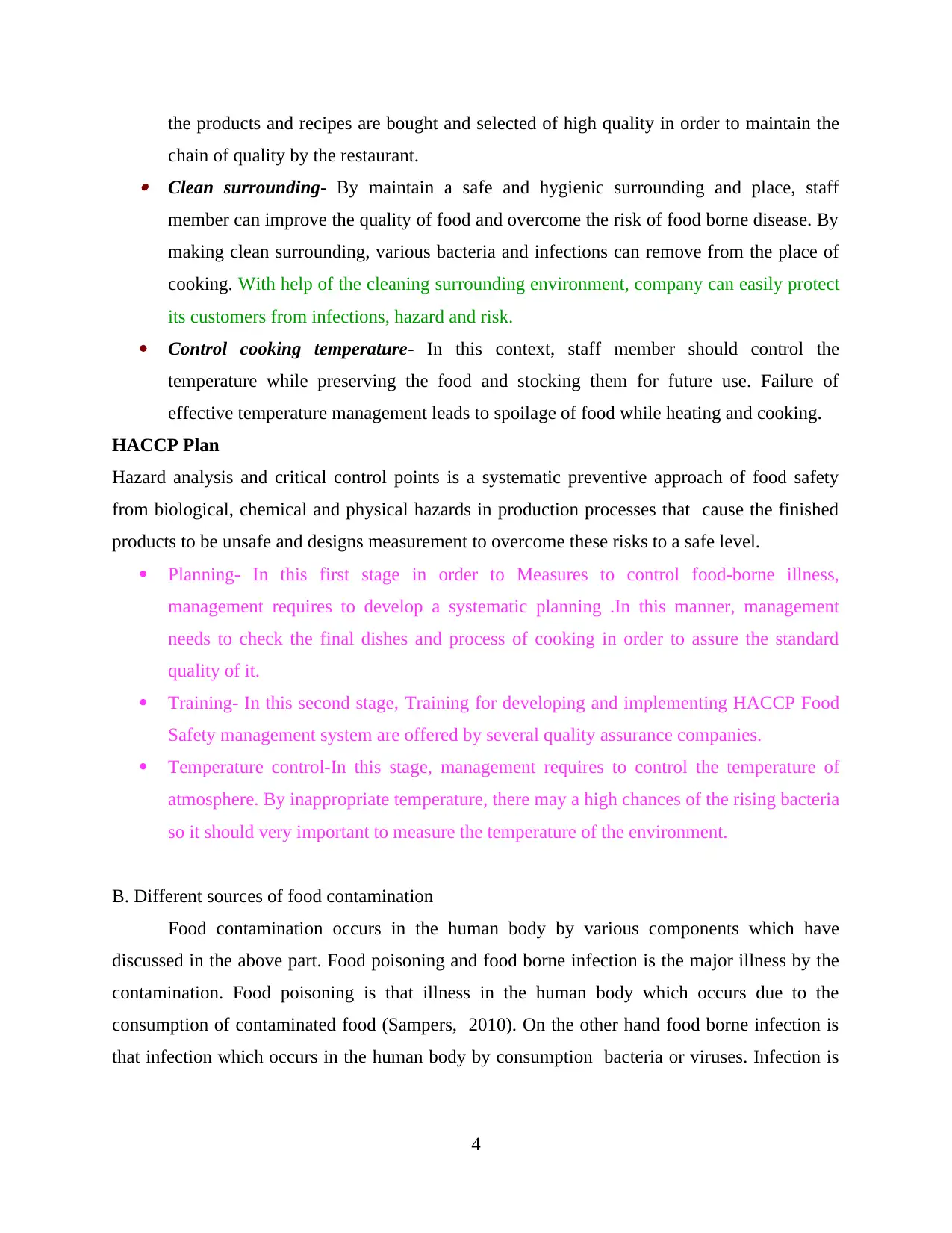
the products and recipes are bought and selected of high quality in order to maintain the
chain of quality by the restaurant. Clean surrounding- By maintain a safe and hygienic surrounding and place, staff
member can improve the quality of food and overcome the risk of food borne disease. By
making clean surrounding, various bacteria and infections can remove from the place of
cooking. With help of the cleaning surrounding environment, company can easily protect
its customers from infections, hazard and risk.
Control cooking temperature- In this context, staff member should control the
temperature while preserving the food and stocking them for future use. Failure of
effective temperature management leads to spoilage of food while heating and cooking.
HACCP Plan
Hazard analysis and critical control points is a systematic preventive approach of food safety
from biological, chemical and physical hazards in production processes that cause the finished
products to be unsafe and designs measurement to overcome these risks to a safe level.
Planning- In this first stage in order to Measures to control food-borne illness,
management requires to develop a systematic planning .In this manner, management
needs to check the final dishes and process of cooking in order to assure the standard
quality of it.
Training- In this second stage, Training for developing and implementing HACCP Food
Safety management system are offered by several quality assurance companies.
Temperature control-In this stage, management requires to control the temperature of
atmosphere. By inappropriate temperature, there may a high chances of the rising bacteria
so it should very important to measure the temperature of the environment.
B. Different sources of food contamination
Food contamination occurs in the human body by various components which have
discussed in the above part. Food poisoning and food borne infection is the major illness by the
contamination. Food poisoning is that illness in the human body which occurs due to the
consumption of contaminated food (Sampers, 2010). On the other hand food borne infection is
that infection which occurs in the human body by consumption bacteria or viruses. Infection is
4
chain of quality by the restaurant. Clean surrounding- By maintain a safe and hygienic surrounding and place, staff
member can improve the quality of food and overcome the risk of food borne disease. By
making clean surrounding, various bacteria and infections can remove from the place of
cooking. With help of the cleaning surrounding environment, company can easily protect
its customers from infections, hazard and risk.
Control cooking temperature- In this context, staff member should control the
temperature while preserving the food and stocking them for future use. Failure of
effective temperature management leads to spoilage of food while heating and cooking.
HACCP Plan
Hazard analysis and critical control points is a systematic preventive approach of food safety
from biological, chemical and physical hazards in production processes that cause the finished
products to be unsafe and designs measurement to overcome these risks to a safe level.
Planning- In this first stage in order to Measures to control food-borne illness,
management requires to develop a systematic planning .In this manner, management
needs to check the final dishes and process of cooking in order to assure the standard
quality of it.
Training- In this second stage, Training for developing and implementing HACCP Food
Safety management system are offered by several quality assurance companies.
Temperature control-In this stage, management requires to control the temperature of
atmosphere. By inappropriate temperature, there may a high chances of the rising bacteria
so it should very important to measure the temperature of the environment.
B. Different sources of food contamination
Food contamination occurs in the human body by various components which have
discussed in the above part. Food poisoning and food borne infection is the major illness by the
contamination. Food poisoning is that illness in the human body which occurs due to the
consumption of contaminated food (Sampers, 2010). On the other hand food borne infection is
that infection which occurs in the human body by consumption bacteria or viruses. Infection is
4
Paraphrase This Document
Need a fresh take? Get an instant paraphrase of this document with our AI Paraphraser
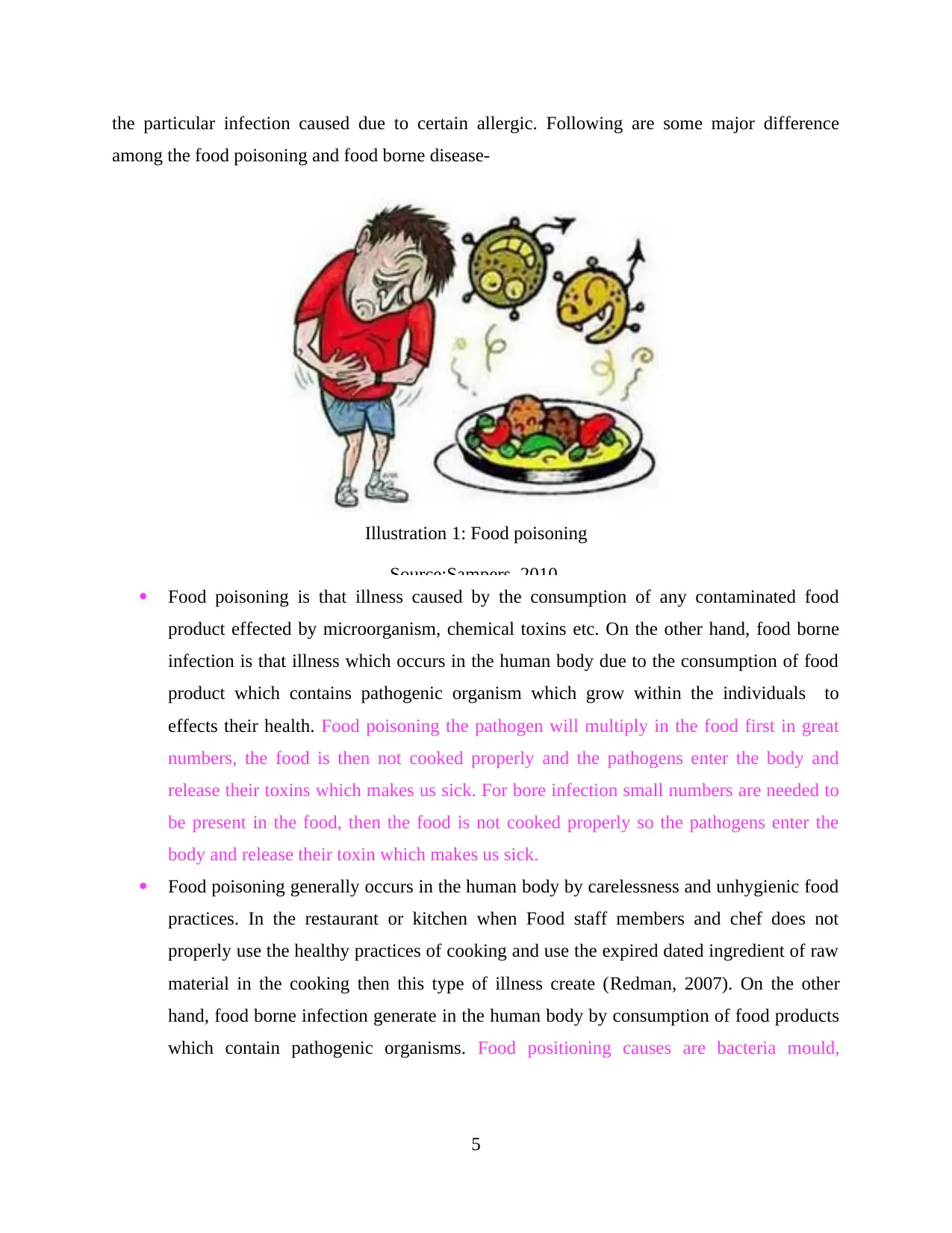
the particular infection caused due to certain allergic. Following are some major difference
among the food poisoning and food borne disease-
Food poisoning is that illness caused by the consumption of any contaminated food
product effected by microorganism, chemical toxins etc. On the other hand, food borne
infection is that illness which occurs in the human body due to the consumption of food
product which contains pathogenic organism which grow within the individuals to
effects their health. Food poisoning the pathogen will multiply in the food first in great
numbers, the food is then not cooked properly and the pathogens enter the body and
release their toxins which makes us sick. For bore infection small numbers are needed to
be present in the food, then the food is not cooked properly so the pathogens enter the
body and release their toxin which makes us sick.
Food poisoning generally occurs in the human body by carelessness and unhygienic food
practices. In the restaurant or kitchen when Food staff members and chef does not
properly use the healthy practices of cooking and use the expired dated ingredient of raw
material in the cooking then this type of illness create (Redman, 2007). On the other
hand, food borne infection generate in the human body by consumption of food products
which contain pathogenic organisms. Food positioning causes are bacteria mould,
5
Illustration 1: Food poisoning
Source:Sampers, 2010.
among the food poisoning and food borne disease-
Food poisoning is that illness caused by the consumption of any contaminated food
product effected by microorganism, chemical toxins etc. On the other hand, food borne
infection is that illness which occurs in the human body due to the consumption of food
product which contains pathogenic organism which grow within the individuals to
effects their health. Food poisoning the pathogen will multiply in the food first in great
numbers, the food is then not cooked properly and the pathogens enter the body and
release their toxins which makes us sick. For bore infection small numbers are needed to
be present in the food, then the food is not cooked properly so the pathogens enter the
body and release their toxin which makes us sick.
Food poisoning generally occurs in the human body by carelessness and unhygienic food
practices. In the restaurant or kitchen when Food staff members and chef does not
properly use the healthy practices of cooking and use the expired dated ingredient of raw
material in the cooking then this type of illness create (Redman, 2007). On the other
hand, food borne infection generate in the human body by consumption of food products
which contain pathogenic organisms. Food positioning causes are bacteria mould,
5
Illustration 1: Food poisoning
Source:Sampers, 2010.
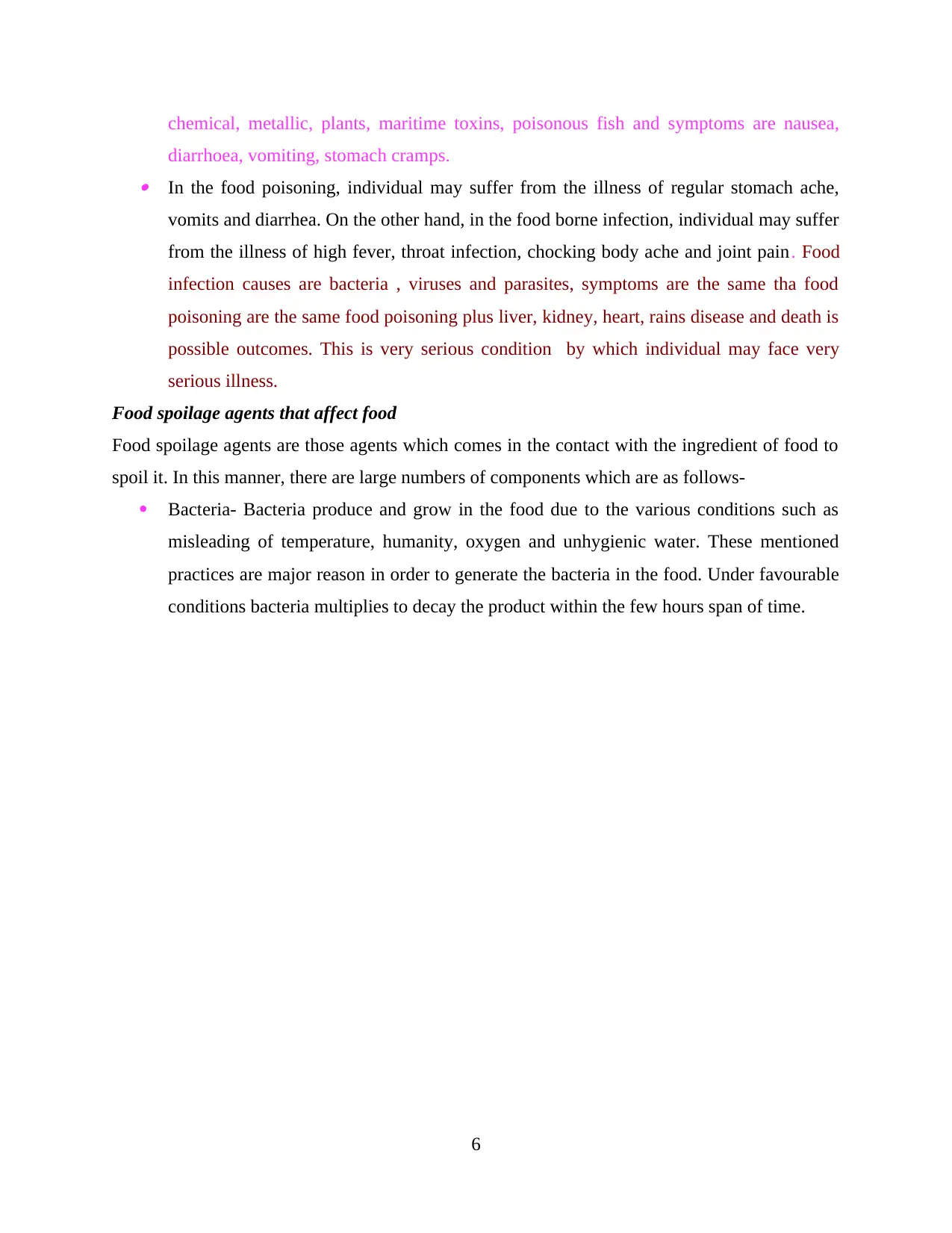
chemical, metallic, plants, maritime toxins, poisonous fish and symptoms are nausea,
diarrhoea, vomiting, stomach cramps. In the food poisoning, individual may suffer from the illness of regular stomach ache,
vomits and diarrhea. On the other hand, in the food borne infection, individual may suffer
from the illness of high fever, throat infection, chocking body ache and joint pain. Food
infection causes are bacteria , viruses and parasites, symptoms are the same tha food
poisoning are the same food poisoning plus liver, kidney, heart, rains disease and death is
possible outcomes. This is very serious condition by which individual may face very
serious illness.
Food spoilage agents that affect food
Food spoilage agents are those agents which comes in the contact with the ingredient of food to
spoil it. In this manner, there are large numbers of components which are as follows-
Bacteria- Bacteria produce and grow in the food due to the various conditions such as
misleading of temperature, humanity, oxygen and unhygienic water. These mentioned
practices are major reason in order to generate the bacteria in the food. Under favourable
conditions bacteria multiplies to decay the product within the few hours span of time.
6
diarrhoea, vomiting, stomach cramps. In the food poisoning, individual may suffer from the illness of regular stomach ache,
vomits and diarrhea. On the other hand, in the food borne infection, individual may suffer
from the illness of high fever, throat infection, chocking body ache and joint pain. Food
infection causes are bacteria , viruses and parasites, symptoms are the same tha food
poisoning are the same food poisoning plus liver, kidney, heart, rains disease and death is
possible outcomes. This is very serious condition by which individual may face very
serious illness.
Food spoilage agents that affect food
Food spoilage agents are those agents which comes in the contact with the ingredient of food to
spoil it. In this manner, there are large numbers of components which are as follows-
Bacteria- Bacteria produce and grow in the food due to the various conditions such as
misleading of temperature, humanity, oxygen and unhygienic water. These mentioned
practices are major reason in order to generate the bacteria in the food. Under favourable
conditions bacteria multiplies to decay the product within the few hours span of time.
6
⊘ This is a preview!⊘
Do you want full access?
Subscribe today to unlock all pages.

Trusted by 1+ million students worldwide

Yeasts- Yeasts are those foods spoilages which grow or develop in high sugar level and
carbon dioxide. In order to give them shape and texture yeasts are used in breads and
other food product development. Jam, bread, pickle are the major example of yeasts
(Arpanutud and et. al., 2009).
Moulds- In order to provide the shape and freeze the product in a particular manner, chef
use the moulds. Generally, through this bake the products in particular shape. If it is not
properly cleaned and washed then there may risk of high spoilage (Nesbitt and et.al.,
2009).
Extrinsic factor- Air, water and temperature are those extrinsic factors which contributes
in the food spoilage. The temperature variation, virus in the air, not covering the food
properly etc are the factor that effects the food spoilage.
Enzyme- Enzyme are proteins that acts as catalysts within living cell. Catalysts increase
the rate at which chemical reactions occurs without being consumed or permanently
7
Illustration 2: Bacteria
Source: Nesbitt and et.al., 2009.
carbon dioxide. In order to give them shape and texture yeasts are used in breads and
other food product development. Jam, bread, pickle are the major example of yeasts
(Arpanutud and et. al., 2009).
Moulds- In order to provide the shape and freeze the product in a particular manner, chef
use the moulds. Generally, through this bake the products in particular shape. If it is not
properly cleaned and washed then there may risk of high spoilage (Nesbitt and et.al.,
2009).
Extrinsic factor- Air, water and temperature are those extrinsic factors which contributes
in the food spoilage. The temperature variation, virus in the air, not covering the food
properly etc are the factor that effects the food spoilage.
Enzyme- Enzyme are proteins that acts as catalysts within living cell. Catalysts increase
the rate at which chemical reactions occurs without being consumed or permanently
7
Illustration 2: Bacteria
Source: Nesbitt and et.al., 2009.
Paraphrase This Document
Need a fresh take? Get an instant paraphrase of this document with our AI Paraphraser
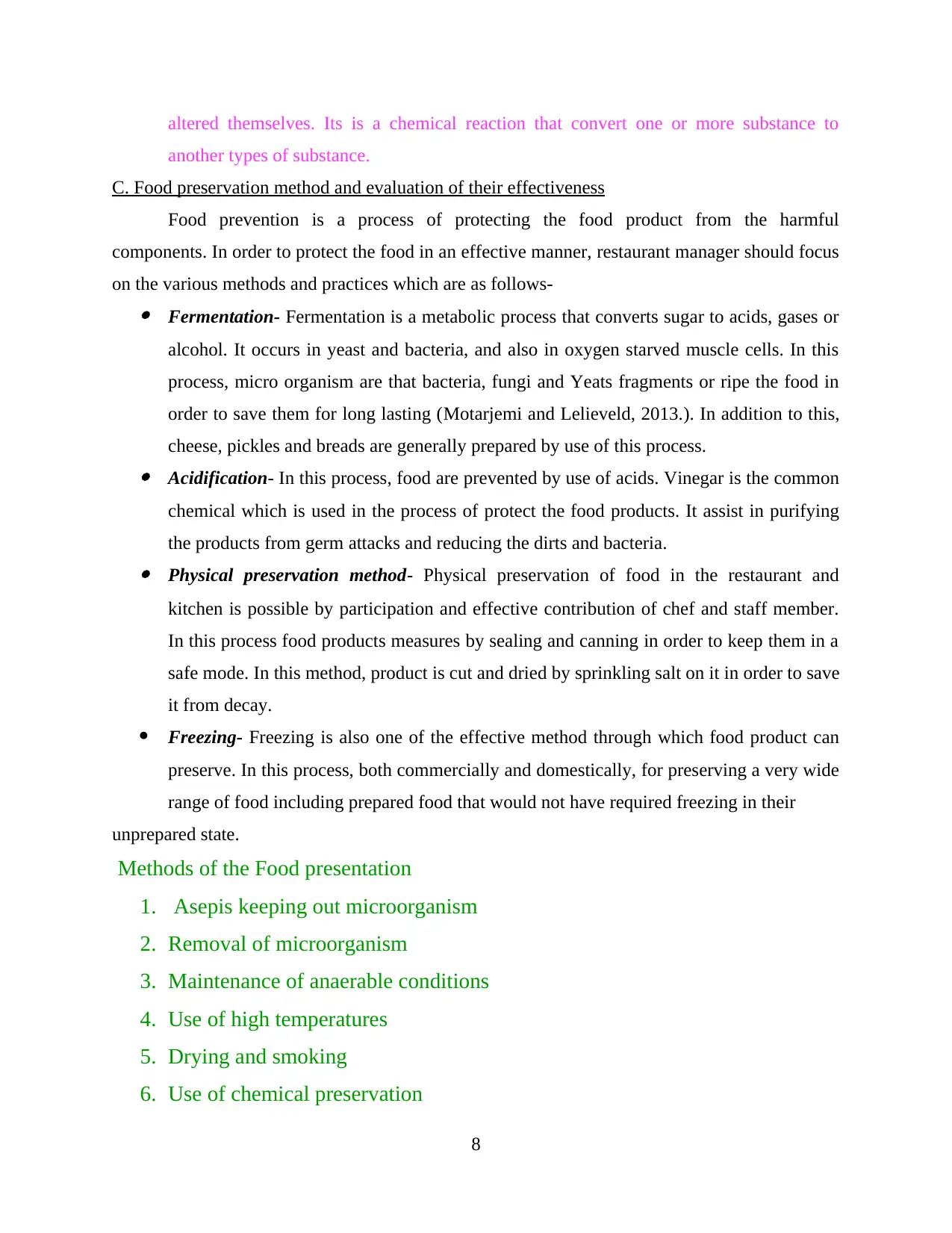
altered themselves. Its is a chemical reaction that convert one or more substance to
another types of substance.
C. Food preservation method and evaluation of their effectiveness
Food prevention is a process of protecting the food product from the harmful
components. In order to protect the food in an effective manner, restaurant manager should focus
on the various methods and practices which are as follows- Fermentation- Fermentation is a metabolic process that converts sugar to acids, gases or
alcohol. It occurs in yeast and bacteria, and also in oxygen starved muscle cells. In this
process, micro organism are that bacteria, fungi and Yeats fragments or ripe the food in
order to save them for long lasting (Motarjemi and Lelieveld, 2013.). In addition to this,
cheese, pickles and breads are generally prepared by use of this process. Acidification- In this process, food are prevented by use of acids. Vinegar is the common
chemical which is used in the process of protect the food products. It assist in purifying
the products from germ attacks and reducing the dirts and bacteria. Physical preservation method- Physical preservation of food in the restaurant and
kitchen is possible by participation and effective contribution of chef and staff member.
In this process food products measures by sealing and canning in order to keep them in a
safe mode. In this method, product is cut and dried by sprinkling salt on it in order to save
it from decay.
Freezing- Freezing is also one of the effective method through which food product can
preserve. In this process, both commercially and domestically, for preserving a very wide
range of food including prepared food that would not have required freezing in their
unprepared state.
Methods of the Food presentation
1. Asepis keeping out microorganism
2. Removal of microorganism
3. Maintenance of anaerable conditions
4. Use of high temperatures
5. Drying and smoking
6. Use of chemical preservation
8
another types of substance.
C. Food preservation method and evaluation of their effectiveness
Food prevention is a process of protecting the food product from the harmful
components. In order to protect the food in an effective manner, restaurant manager should focus
on the various methods and practices which are as follows- Fermentation- Fermentation is a metabolic process that converts sugar to acids, gases or
alcohol. It occurs in yeast and bacteria, and also in oxygen starved muscle cells. In this
process, micro organism are that bacteria, fungi and Yeats fragments or ripe the food in
order to save them for long lasting (Motarjemi and Lelieveld, 2013.). In addition to this,
cheese, pickles and breads are generally prepared by use of this process. Acidification- In this process, food are prevented by use of acids. Vinegar is the common
chemical which is used in the process of protect the food products. It assist in purifying
the products from germ attacks and reducing the dirts and bacteria. Physical preservation method- Physical preservation of food in the restaurant and
kitchen is possible by participation and effective contribution of chef and staff member.
In this process food products measures by sealing and canning in order to keep them in a
safe mode. In this method, product is cut and dried by sprinkling salt on it in order to save
it from decay.
Freezing- Freezing is also one of the effective method through which food product can
preserve. In this process, both commercially and domestically, for preserving a very wide
range of food including prepared food that would not have required freezing in their
unprepared state.
Methods of the Food presentation
1. Asepis keeping out microorganism
2. Removal of microorganism
3. Maintenance of anaerable conditions
4. Use of high temperatures
5. Drying and smoking
6. Use of chemical preservation
8
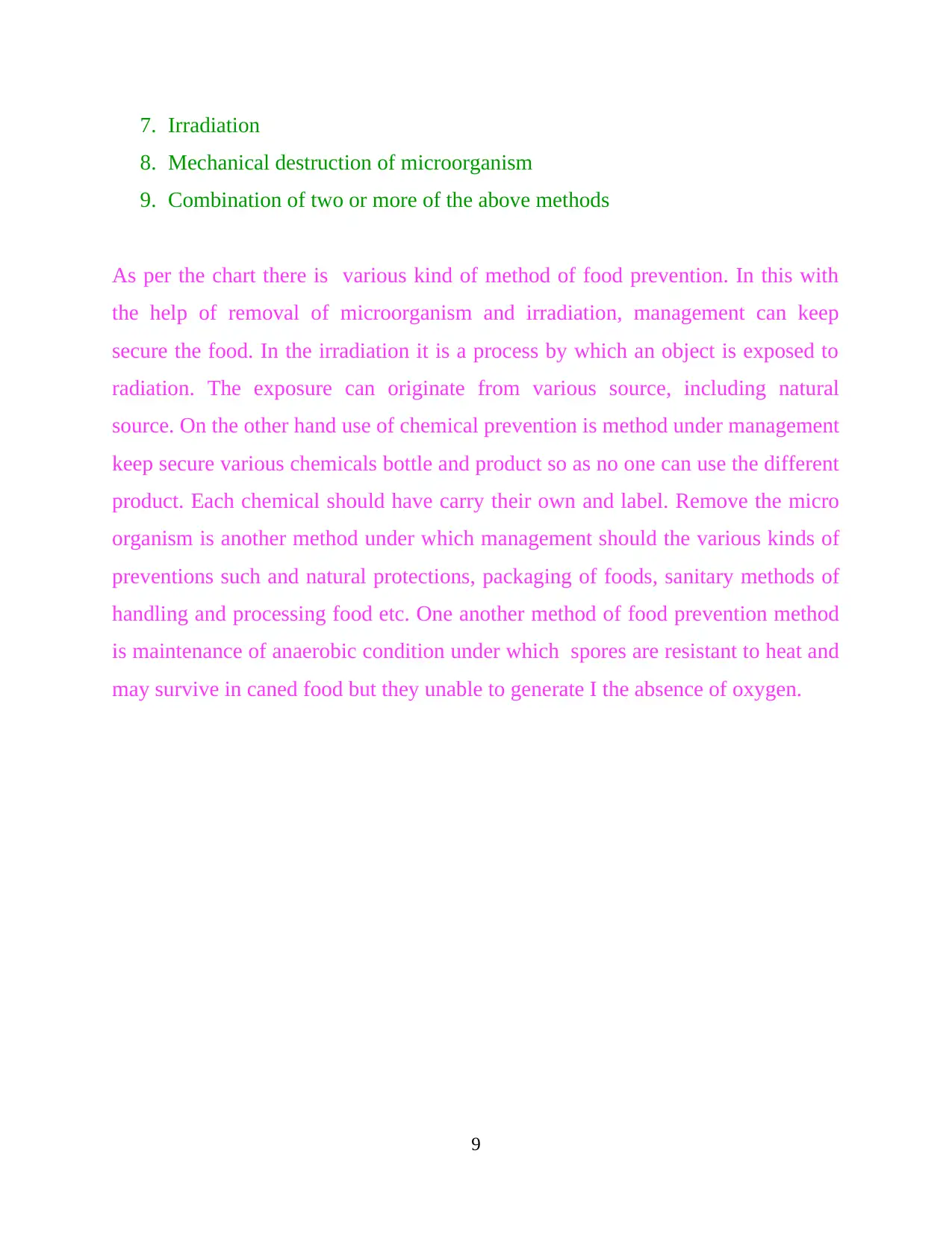
7. Irradiation
8. Mechanical destruction of microorganism
9. Combination of two or more of the above methods
As per the chart there is various kind of method of food prevention. In this with
the help of removal of microorganism and irradiation, management can keep
secure the food. In the irradiation it is a process by which an object is exposed to
radiation. The exposure can originate from various source, including natural
source. On the other hand use of chemical prevention is method under management
keep secure various chemicals bottle and product so as no one can use the different
product. Each chemical should have carry their own and label. Remove the micro
organism is another method under which management should the various kinds of
preventions such and natural protections, packaging of foods, sanitary methods of
handling and processing food etc. One another method of food prevention method
is maintenance of anaerobic condition under which spores are resistant to heat and
may survive in caned food but they unable to generate I the absence of oxygen.
9
8. Mechanical destruction of microorganism
9. Combination of two or more of the above methods
As per the chart there is various kind of method of food prevention. In this with
the help of removal of microorganism and irradiation, management can keep
secure the food. In the irradiation it is a process by which an object is exposed to
radiation. The exposure can originate from various source, including natural
source. On the other hand use of chemical prevention is method under management
keep secure various chemicals bottle and product so as no one can use the different
product. Each chemical should have carry their own and label. Remove the micro
organism is another method under which management should the various kinds of
preventions such and natural protections, packaging of foods, sanitary methods of
handling and processing food etc. One another method of food prevention method
is maintenance of anaerobic condition under which spores are resistant to heat and
may survive in caned food but they unable to generate I the absence of oxygen.
9
⊘ This is a preview!⊘
Do you want full access?
Subscribe today to unlock all pages.

Trusted by 1+ million students worldwide
1 out of 24
Related Documents
Your All-in-One AI-Powered Toolkit for Academic Success.
+13062052269
info@desklib.com
Available 24*7 on WhatsApp / Email
![[object Object]](/_next/static/media/star-bottom.7253800d.svg)
Unlock your academic potential
Copyright © 2020–2025 A2Z Services. All Rights Reserved. Developed and managed by ZUCOL.





